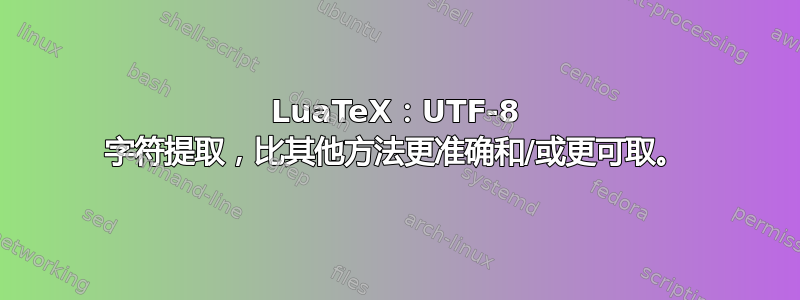
在尝试从 TeX 框中提取 UTF-8 字符串的方法时,我发现了用户micahl-h21 是这里:UTF-8 文本提取。在查看了字形数据存储在节点列表中的方式后,我修改了代码以查看是否有其他方法可行。在我的方法中,我遍历组合复杂字形/圆盘的组件以提取组成字符。在他的方法中,他似乎将连字等复杂字形传递给某个函数来分解它。我们两个代码(对于示例中的测试字符串)打印的输出看起来相同。有人可以检查一下,并建议这两种方法是否同样功能正确(我知道我的代码需要对 TeX 连字进行特殊处理,请忽略这一点)。如果是,哪一种对性能更好(我可以unicode.utf8.char像他一样在我的代码中缓存,请忽略任何有关性能的评论中的差异)。
以下是写入终端和输出文件 hello.txt 的输出文本:Příliš žluťoučký kůň úpěl ďábelské ódy difference diffierence.他的完整代码位于UTF-8 文本提取,我们的代码不同的地方在于我没有使用他的以下函数(get_unicode),而只是坚持unicode.utf8.char(glyphnodename.char)应用于字形组件(而他应用这个函数get_unicode来分解复杂的字形,而不是在字形节点中挖掘更深的级别来获取分解的字形[据我所知])。
local function get_unicode(xchar,font_id)
local current = {}
local uchar = identifiers[font_id].characters[xchar].tounicode
for i= 1, string.len(uchar), 4 do
local cchar = string.sub(uchar, i, i + 3)
print(xchar,uchar,cchar, font_id, i)
table.insert(current,char(tonumber(cchar,16)))
end
return current
end
\documentclass{article}
\usepackage[lmargin=0.5in,tmargin=0.5in,rmargin=0.5in,bmargin=0.5in]{geometry}
\usepackage{fontspec}
\usepackage{microtype}
\usepackage[english]{babel}
\usepackage{blindtext}
\begin{document}
\setbox0=\hbox{Příliš žluťoučký \textit{kůň} úpěl \hbox{ďábelské} ódy difference diffierence.}
\directlua{
local glyph_id = node.id("glyph")
local disc_id = node.id("disc")
local glue_id = node.id("glue")
local hlist_id = node.id("hlist")
local vlist_id = node.id("vlist")
local minglue = tex.sp("0.2em")
local function nodeText(n)
local t = {}
for x in node.traverse(n) do
% glyph node
if x.id == glyph_id then
if bit32.band(x.subtype,2) \csstring~=0 and unicode.utf8.char(x.char) \csstring~="“" and unicode.utf8.char(x.char) \csstring~="”" then %
for g in node.traverse_id(glyph_id,x.components) do
if bit32.band(g.subtype, 2) \csstring~=0 then
for gc in node.traverse_id(glyph_id,g.components) do
table.insert(t,unicode.utf8.char(gc.char))
end
else
table.insert(t,unicode.utf8.char(g.char))
end
end
else
table.insert(t,unicode.utf8.char(x.char))
end
% disc node
elseif x.id == disc_id then
for g in node.traverse_id(glyph_id,x.replace) do
if bit32.band(g.subtype, 2) \csstring~=0 then
for gc in node.traverse_id(glyph_id,g.components) do
table.insert(t,unicode.utf8.char(gc.char))
end
else
table.insert(t,unicode.utf8.char(g.char))
end
end
% glue node
elseif x.id == glue_id and node.getglue(x) > minglue then
table.insert(t," ")
elseif x.id == hlist_id or x.id == vlist_id then
table.insert(t,nodeText(x.head))
end
end
return table.concat(t)
end
local n = tex.getbox(0)
print(nodeText(n.head))
local f = io.open("hello.txt","w")
f:write(nodeText(n.head))
f:close()
}
\box0
\end{document}


